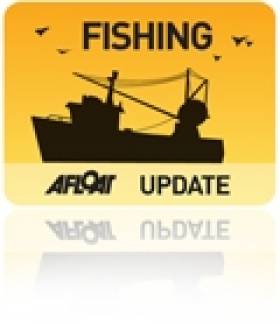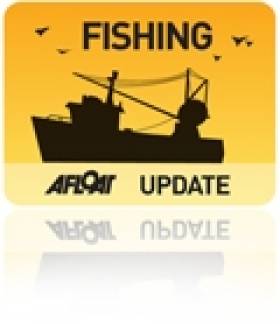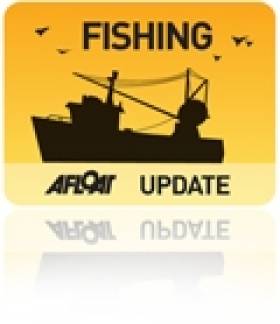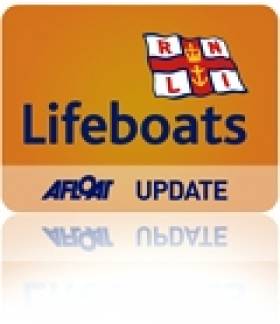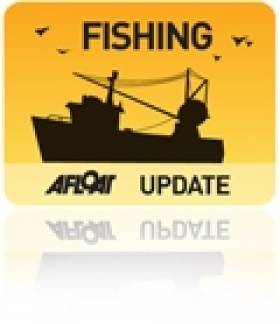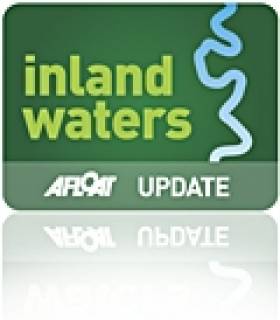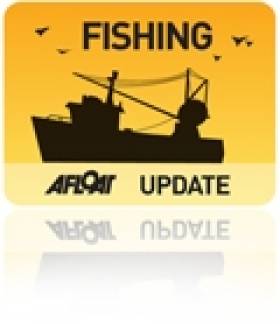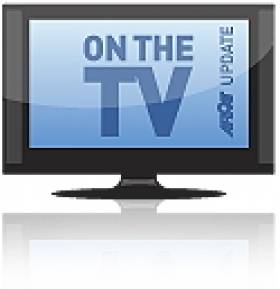Displaying items by tag: Fishing
Sustainability of Fish Stocks Improving Says Minister
#Fishing - Dr Peter Heffernan, CEO of the Marine Institute, presented the Minister for the Marine Simon Coveney with The 2012 Stock Book ahead of the EU Fisheries Council negotiations next week, noting an improvement in certain fish stocks with a higher number of stocks sustainably fished in 2012 compared with 2011 - as Tom McSweeney writes about in his column last Friday.
The Stock Book gives an overview of 59 stocks from which Ireland has an EU quota allocation and will be used to inform discussions and decisions on Total Allowable Catches (TACs) fishing quotas for 2013. TACs and quotas will be decided at the December EU Fisheries Council on 18-20 December which will be attended by the minister, who has lately faced criticism over the proposed deep-sea salmon farm in Galway Bay.
Minister Coveney said: "I welcome the comprehensive review carried out by the Marine Institute showing the state of fish stocks that are of importance to Ireland. Of the 59 stocks in which Ireland has a share of the EU TAC, 42% are now fished sustainably compared to 36% in 2011. The state of the resource base in terms of the biomass, the population of mature fish in the stock, has also improved. The number of depleted stocks has declined from 12 to 8.
"It is good to see progress on delivering sustainable fishing. Further efforts are needed both in terms of setting TAC levels and also taking other measures such as reducing catches of juvenile fish and dealing with unacceptable levels of discards.
He added: "Having the latest scientific information at my fingertips is essential at the December council. My approach to the negotiations will be to utilise this science to ensure EU fishing policy secures the long term sustainability of the industry.
"The December Council negotiations must concentrate on achieving a more practical and pragmatic regime for the fishing industry, grounded in the scientific data available in the Stock Book.”
The Stock Book advice is developed using the latest available research, assessments and advice on the fisheries resource. Irish scientists collaborate with other international scientists at the International Council for the Exploration of the Seas (ICES).
“ICES is a key forum for Ireland where our scientists develop impartial scientific advice that meets best international standards,” said Dr Heffernan.
The Stock Book is presented annually to Department of Agriculture, Food and the Marine. The information is of vital importance in serving Ireland during the annual TAC negotiations at the various EU Council of Fisheries meetings, but principally at the December council meeting where the quotas for the following year are set.
It is also of interest to a wider audience, including the fishing industry, marine scientists, managers, environmental NGOs, third level institutes, financial institutions and those with an interest in the status and management of marine fisheries resources in the waters around Ireland.
The Stock Book has been published by the Marine Institute since 1993 and has evolved considerably in that time period. It continues to evolve in a changing fisheries advisory environment. The Stock Book is available electronically on the Marine Institute’s website HERE.
Chinese Permit Irish Exports of Boarfish
#fishing – The Minister for Agriculture Food and the Marine, Simon Coveney, TD today welcomed the announcement made by the Chinese authorities via the Irish Embassy in Beijing, that commercial exports of Boarfish from Ireland may now be imported to China.
This development follows the visit last April to China of the largest ever Irish agri-food delegation to China which was led by Minister Coveney. Commenting on the announcement, Minister Coveney said "China is a key strategic trade partner for Ireland and has a strong demand for imports of high quality seafood, given the size of its population. Ireland is well placed to be a key supplier of sea food, meats, dairy products and beverages as well as other products and services to China. I am delighted that this announcement on Boarfish imports, which was the subject of specific discussions on my mission last April, is yet another positive development from that trade mission".
Boarfish has become much more abundant off the south coast of Ireland. In recent years, the Irish fishing fleet has developed a very important fishery on this species for the production of fishmeal and fish oils and increasingly for the creation of human consumption seafood products.
A Total Allowable Catch and National Quotas were introduced at EU level for Boarfish for the first time in 2011. Ireland successfully negotiated a very significant new Irish national fish quota, equating to 2/3 of the overall EU total allowable catch (TAC). The quota for Ireland in 2012 was 56, 666 tonnes making this new fishery one of our largest commercial fisheries. To date in 2012, thirty nine large Irish trawlers have caught over 53,000 tonnes of Boarfish. The overall long term sustainability of this species is promising and a new quota for 2013 will be negotiated by Minister Coveney at the upcoming Fisheries Council.
Following Minister Coveney's trade mission to China in April, Ireland has been pursuing a co-ordinated strategy to realise the potential offered by the new Boarfish Fishery. Trial samples of over 70 tonnes were sent to Chinese Seafood companies this year and these have lead to orders for commercial scale exports. BIM and Bord Bia have been working to create new products from this new resource and to find new human consumption markets so as to ensure that the Irish Seafood industry can get the maximum value and employment from the resource. The Sea Fisheries Protection Authority have worked closely with their Chinese counterparts AQSIQ to ensure that all the seafood safety and other trade certification requirements can be met to successfully allow commercial exports of Boarfish.
The Minister concluded "I expect that the opening of the Chinese Market for commercial export of Boarfish products from Ireland will enable our Seafood Processors and Exporters to develop a very significant human consumption market for Irish Boarfish products in China, to the benefit of the whole seafood industry along our western and southern seaboard".
Fishing Boat Fire off Malin Head Leads to Court Appearance
At a hearing today at Southampton Crown Court the owner and manager of a fishing vessel were fined a total of £180,000 including costs. They had pleaded guilty to charges relating to health and safety offences brought under fishing vessel safety legislation
On 7 January 2008 the UK registered fishing vessel Shark sailed from La Corunna in Spain with a crew of 16, mainly Spanish and Portuguese nationals. On 19 January 2008 the Shark suffered a severe accommodation fire while at sea approximately 17 miles to the west of Malin Head. The fire on board the Shark was extensive. It extended to the galley kitchen, and three cabins used by the crew for sleeping, to alleyways in the accommodation section of the boat and the upper parts of the vessel. In two of the sleeping cabins the bunks, bedding, furnishings and lockers were totally consumed by fire. The crew were badly affected by smoke.
A major search and rescue operation, involving UK and Irish Coastguard, helicopters, lifeboats and Irish Navy, took place. Fourteen of the crew were evacuated by lifeboat and helicopter from the vessel. The fire was extinguished by members of the Irish Navy. The Shark eventually made it to Killybegs, Republic of Ireland.
After arrival the vessel was inspected by surveyors from the MCA. Several major defects were noted, many of which were noted to have pre-dated the fire and affected the safe operation of the vessel. An investigation by the Enforcement Unit of the Maritime and Coastguard Agency was started into the operation of the Shark by its owner, Generic Enterprises Ltd, and managers, Hooktone Ltd.
At an earlier hearing in Magistrates Court, the owner of the Shark, Generic Enterprises Ltd had pleaded guilty to a charge brought under the Merchant Shipping and Fishing Vessels (Health and Safety at Work) Regulations 1997 for failing to ensure the health and safety of the crew. However owing to the seriousness of the offence, the matter was passed to Crown Court for sentencing. At today's hearing, they were fined £100,000 plus costs of £35,000.
Following legal argument, the vessel's managers, Hooktone Ltd., changed their plea to guilty for a breach of the Merchant Shipping and Fishing Vessels (Health and Safety at Work) Regulations 1997 for failing to ensure the health and safety of the crew. They were fined £20,000 plus costs of £25,000.
His Honour Judge Ralls QC stated that Generic Enterprises Ltd had a high responsibility for the safety of the crew and vessel and that their duty had fallen well below standard. He also pointed out that Generic Enterprises Ltd had adopted a cavalier attitude to safety. When passing sentence He added that Hooktone Ltd culpability for the offence was at a lower level.
Fish Quota Proposals Means Difficult Negotiations Lie Ahead for Coveney
#fishing – The Minister for Agriculture, Food and the Marine, Simon Coveney TD, presented to the Joint Oireachtas Committee on Agriculture, Food and the Marine today a Sustainability Impact Assessment of the EU Commission proposals for Total Allowable Catches (TACs) and quotas for 2013.
The TACs and quotas will be decided at the December EU Fisheries Council on 18 to 20th December. The Sea Fisheries Sustainability Impact Assessment has been carried out in line with the commitment in the Programme for Government and is now publicly available on www.fishingnet.ie . The Sustainability Impact Statement, which has been prepared by the Department working with the Marine Institute and BIM, reviews all the stocks of importance to Ireland taking account of the scientific advice on the stocks. The Impact Assessment acknowledges that while many stocks in which the Irish fleet have an interest are not in a healthy biological state, there has been an improvement in 2012 on the state of fish stocks.
Minister Coveney said "I welcome the comprehensive review of the state of fish stocks of importance to Ireland which has been carried out by the Marine Institute. Of the 59 stocks in which Ireland has a share of the EU TAC, 42% are now fished sustainably compared to 36% in 2011. The state of the resource base in terms of the biomass, the population of mature fish in the stock, has also improved. The number of depleted stocks has declined from 12 to 8. It is good to see progress on delivering sustainable fishing. Further efforts are needed both in terms of setting TAC levels and also taking other measures such as reducing catches of juvenile fish and dealing with unacceptable levels of discards. These issues will be a priority for me during the Irish Presidency work programme on the reform of the Common Fisheries Policy in the first half of 2013".
The statement also sets down the economic importance of stocks and the likely impacts of the Commission's proposals from a socio-economic perspective. Minister Coveney said "It is very clear from the analysis undertaken by BIM that the current proposals would have significant consequences on our fishing industry and our dependant coastal communities. Potentially there is a loss of approximately €15.5m for our whitefish and prawn fishing industry as well as knock on effects for processors and hauliers etc. This equates to losses in the order of €53m for coastal communities where the direct cost and indirect costs (processing, net making etc) are taken into account".
Minister Coveney added "We must continue to ensure that the state of fish stocks is not compromised and the scientific advice provided informs decisions on TACs and quotas for 2013. I will work in close consultation with the fishing industry and other stakeholders during the December Fisheries Council to deliver quotas for Ireland that involve reductions only where justified and that a rational and prudent account is taken of the available scientific information to inform the Council's decisions".
Donaghdee RNLI Comes To Aid of Drifting Fishing Boat
#RNLI - Donaghadee RNLI has assisted two people whose boat got into difficulty off Co Down.
The station’s volunteer lifeboat crew was out on a training exercise on Sunday morning when they were requested to go to the aid of a 30-ft fishing vessel off the Copeland Islands.
Two people were on board the vessel which was drifting off South Briggs. Within minutes the lifeboat was on the scene and found the vessel had a rope around its propeller.
The lifeboat crew was able to establish a tow rope across to the vessel and towed it safely into Groomsport Harbour.
BIM to Hold Public Tender for Galway Bay Fish Farm
#FISHFARM - Bord Iascaigh Mhara (BIM) is set to hold a public tender process for the development of the proposed deep sea fish farm in Galway Bay, according to The Irish Times.
Financiers around the world have expressed interest in the 500-hectare organic salmon farm to be located off Inis Oirr in the Aran Islands, though BIM said it was not at liberty to disclose who they are.
As previously reported on Afloat.ie, the proposed fish farm would be the largest of its kind in Europe, set to double the State's production of organic salmon.
BIM says it is already receiving inquiries for jobs from emigrants wishing to return home.
However the scheme has faced opposition from Inland Fisheries Ireland (IFI) and local anglers, who cite the potential threat to wild salmon numbers in the area.
IFI recently issued a statement regarding its submission on the project's Environmental Impact Statement, raising concerns about the scale of the development and the impact of sea lice - infestations of which are often concentrated by aquaculture.
The public consultation that began in mid-October is scheduled to conclude next Wednesday 12 December.
Lough Swilly RNLI Rescues Crew From Stricken Fishing Boat
#RNLI - Lough Swilly RNLI rescued five people onboard a 50ft fishing boat yesterday evening (Sunday 2 December) after the vessel’s engine broke down in Co Donegal.
During what was a nine-hour callout in tough weather conditions, Portrush RNLI also launched to assist the stricken Mary Ellen.
Volunteer crew members from Lough Swilly had been attending a commemoration in Portsalon when they were requested to launch to the boat that had broken down some 10 miles further on, a mile-and-a -half from Fannad Lighthouse.
The all-weather Tyne class lifeboat arrived on scene at 3.15pm where the crew observed a steel crabber with five men onboard. The fishing boat was carrying a load of crab.
Weather conditions at the time were described as blowing gusts of between gale force 5 and 6 up the lough.
The crew pursued to establish a towline and commence the return journey to shore. After towing the vessel for a couple of hours into the dark, the tide began to turn, making the pull more difficult. A relief lifeboat from Lough Swilly and Portrush RNLI were requested to launch to assist.
Irish Coast Guard helicopter Rescue 118 was also on scene in the event that the stricken vessel’s crew would need to be evacuated.
As the boat was being towed up the lough it lost all power and VHF was transferred from the lifeboat for communication.
When Portrush RNLI arrived on scene, the crew assisted with the tow while the Lough Swilly relief lifeboat stood by.
The stricken vessel’s mechanic managed to restart the engine during the tow and the vessel made its way into Rathmullan while the Lough Swilly lifeboat stood by in case it required further assistance.
John McCarter, Lough Swilly RNLI lifeboat operations manager, paid tribute to the lifeboat crew who arrived back at the station in the early hours of Monday morning.
"This was a long callout in difficult weather conditions and we are glad that we were able to assist this vessel and her crew in making it to shore safely,: he said.
"This was a testament of the commitment, skill and selfless nature of our volunteers who are always willing to give their time and readily leave the comfort of their homes to face challenging conditions to help people who find themselves in difficulty at sea."
Joe Joyce from the lifeboat crew told BBC News that the nine-hour operation was "an unpleasant experience" but reported that "everybody was safe and well".
Minister Launches Fisheries Conservation Conference
#INLAND FISHERIES - Minister of State Fergus O’Dowd was on hand to launch the Atlantic Aquatic Resource Conservation (AARC) conference in Limerick on Wednesday 28 November.
The conference, attended by delegates from five countries, is intended to showcase integrated collaborative water resource management projects across the European Atlantic Arc, comprising Portugal, Spain, France, Britain and Ireland.
The AARC project is the culmination of work undertaken by 13 international partnerships across these five countries, and the conference provides an opportunity to share the research, findings and recommendations to support the conservation of native fish species.
As the project nears conclusion next month, all AARC project requirements have been met and exceeded in a number of cases, according to Inland Fisheries Ireland (IFI).
In Ireland specifically, the project has made a valuable contribution to the Shannon Salmon Restoration Plan (SSRP) which looks at redressing the decline in Atlantic salmon populations throughout the Shannon river system.
Overall, says IFI, AARC has provided an important instrument to facilitate a pan-European approach to conserving our indigenous, migratory fish stocks.
Speaking at the launch of the conference, Minister O’Dowd highlighted the importance of EU research programmes like AARC in enhancing international research and collaboration.
“The strong inter-regional co-operation, under AARC, between regional authorities and research institutions has increased our knowledge of the conservation requirements of these important European fish species,” he said.
“AARC has ensured that we will play our part in utilising this new knowledge and co-operation for the enhancement of the conservation status of important EU species and habitats.”
AARC is a three-year project, launched in 2009, which focuses on migratory stocks of protected fish species: shad, Atlantic salmon, sea trout, sea lamprey, European eel and smelt. Across Europe these species have economic, cultural and environmental value but are in decline.
The issue of their decline is truly transnational, says IFI, and can only be addressed through long-term intensive transnational collaboration.
A major theme running through the AARC project was establishing the role of wider stakeholders in the management of our aquatic resources. Many of the AARC partners have worked to engage local stakeholders in protecting, conserving and managing these resources through the AARC project activities.
In Ireland, the project dealt with restorative initiatives for Atlantic salmon in the Shannon system. This included determining the genetic composition of contemporary and historical populations of salmon in the Shannon and comparing the relative performance in the wild of the progeny Feale, Mulkear and Shannon wild and hatchery salmon populations.
IFI was joined in the project by fellow partners ESB Fisheries Conservation, University College Cork and the Marine Institute. Of the total project budget of €3.87m, Irish partners received €754,242 over the three years.
The Shannon AARC project will address issues pertaining to fish passage, water quality, habitat and hatchery programmes in addition to the construction of a project specific geograpgic information systems (GIS), co-ordination of stock assessment surveys and the promotion of catchment management.
Ultimately it will help identify important factors in the conservation of Atlantic salmon in the Shannon, and will provide a set of useful maps and a spatial visualisation tool for improved planning and development throughout the Shannon catchment.
Results will help inform fisheries staff of the current status of Atlantic salmon populations in the Shannon as well as provide a useful inventory or potential and/or historical salmon locations in the Shannon.
The project will also benefit inter-agency co-operation, particularly in relation to River Shannon fisheries management, and will strengthen the links with relevant research institutions and international fisheries experts.
Coveney Warns Brussels on Irish Mackerel Industry
#fishing– Simon Coveney TD, Minister for Agriculture, Food and Marine warned the Council of Fisheries Ministers in Brussels today, that the over reliance on pelagic stocks for the annual exchange in fishing opportunities with Norway is having a detrimental effect on our own Pelagic fleet with knock on consequences for our processors.
Minister Coveney said " EU/Norway is a very important agreement for the EU, but Ireland has traditionally lost out in the overall exchange of fishing opportunities because key pelagic stocks of interest to us, in particular Blue Whiting, form part of the exchange for Arctic Cod, where we gain little".
Norway's Pelagic fleet will see large reductions in their Atlanto Scandian Herring(ASH) and mackerel quotas for 2013, and are demanding large increases in the amount of Blue Whiting and other pelagic stocks to offset this, they have large amounts of Arctic cod to offer in return, but Ireland receives only a small share of this. Minister Coveney explained "the Irish Pelagic fleet is experiencing the same reductions on Norwegian herring and mackerel and to expect them to suffer more hardship by transferring increased amounts of Blue Whiting and Horse mackerel to Norway is unfair and unacceptable, and I made my views on this crystal clear at the Council".
On the question of setting fishing levels for mackerel, Ireland's most important stock, the Minister said "I am concerned about the state of the mackerel stock which is being threatened by the irresponsible and unsustainable fishing by Iceland and the Faroe islands on the stock. I support following ICES scientific advice on setting the 2013 mackerel TAC. I do not however consider that it is reasonable to reduce further the EU share of the stock in response to overfishing of Iceland and the Faroe Islands".
Ireland has secured support at Council on this issue from the United Kingdom, France, Spain, Portugal and Poland. Minister Coveney went on to say "I believe that the EU and Norway, as the major shareholders should agree to implement without delay a joint approach including trade sanctions to bring pressure to bear on Iceland and the Faroe islands to come to the table with justifiable demands on a cohesive management framework for the stock which is in all our interests".
Talks between the EU and Norway on the annual fishing agreement and on mackerel commence next week in Bergen, Norway and are scheduled to conclude on Friday 7th December.
Bass Angling Feature on Tonight's 'Ear to the Ground'
#ON THE TV - Tonight's episode of Ear to the Ground on RTÉ One will feature a report on bass angling in Ireland, and the commercial fishing sector's efforts to re-open bass fisheries.
Among those interviewed for the feature were Dr Ed Fahy, who gave a talk at the recent Hook Bass Angling Festival discussing the threat to Ireland's sea bass should the fishery be opened to commercial interests, and argueing the case for bass angling tourism as a greater boon for the economy.
Ear to the Ground is broadcast tonight at 8.30pm on RTÉ One.


























